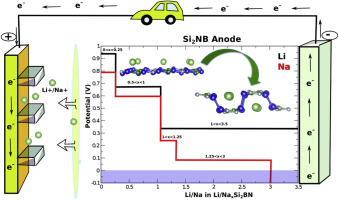Nano Energy ( IF 17.6 ) Pub Date : 2017-09-19 , DOI: 10.1016/j.nanoen.2017.09.026 Vivekanand Shukla , Rafael B. Araujo , Naresh K. Jena , Rajeev Ahuja

|
The ubiquity of silicon in the semiconductor industry and its unique charge transport features has consistently fueled interest in this element and recent realization 2D silicene is a new feather in its cap. In what could be considered as opening up the Pandora's box with many possible virtues, buckled silicene, planar graphene and a host of other newly discovered 2D materials have redefined a whole new paradigm of research. To this end, the quest for new 2D materials and finding potential applications, particularly to the realm of energy storage, is a curiosity driven task. From first principle density functional theory studies, a newly reported graphene like 2D material Si2BN is investigated as a probable anode material for Li and Na ion batteries. In contrast to pristine silicene, which is inherently buckled, the material Si2BN is planar. However, an interesting transition from planar to buckled structure takes place upon subsequent adsorption of Li and Na ions. Concomitantly, this transition is associated with superior specific capacity (1158.5 and 993.0 mA h/g respectively for Li and Na) which is significantly higher than several other 2D analogues. Furthermore, the substrate Si2BN regains the planar structure on subsequent desorption of ions and stability of the material remains intact, as evidenced from ab initio molecular dynamics simulations. As we delve deep into the electronic structure and compute the diffusion pathways and barriers, it is observed that the ionic diffusion is very fast with significantly lesser barrier heights, particularly for Na-ion. These findings suggest that for the 2D Si2BN, there is no diminution in order to be a potential anode material for Li and Na ion batteries.
中文翻译:

二维Si 2 BN的奇怪案例:高容量电池负极材料
硅在半导体工业中的普遍存在及其独特的电荷传输特性一直在激发人们对该元素的兴趣,最近人们意识到2D硅是其新的亮点。可以认为潘多拉魔盒具有许多可能的优点,屈曲的硅烯,平面石墨烯和许多其他新近发现的2D材料重新定义了一种全新的研究范式。为此,寻求新的2D材料并寻找潜在的应用程序,尤其是在能量存储领域,是一项由好奇心驱动的任务。根据第一原理密度泛函理论研究,新报道的类似于2D材料Si 2的石墨烯研究了BN作为锂和钠离子电池的负极材料。与固有地弯曲的原始硅石相反,材料Si 2 BN是平面的。然而,在随后的Li和Na离子吸附之后,发生了从平面结构到弯曲结构的有趣转变。同时,这种转变与更高的比容量(Li和Na分别为1158.5和993.0 mA h / g)相关,该比容量明显高于其他几个2D类似物。此外,衬底Si 2从头开始的分子动力学模拟可以证明,BN在随后的离子解吸中恢复了平面结构,并且材料的稳定性保持不变。当我们深入研究电子结构并计算扩散路径和势垒时,可以观察到离子扩散非常快,势垒高度明显减小,尤其是对于钠离子而言。这些发现表明,对于2D Si 2 BN来说,锂和钠离子电池的潜在阳极材料并没有减少。



























 京公网安备 11010802027423号
京公网安备 11010802027423号